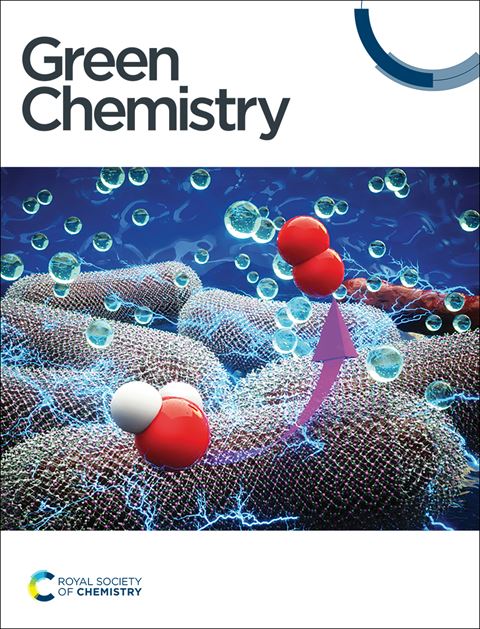烯烃的高效电环氧化反应及溴的回收
IF 9.3
1区 化学
Q1 CHEMISTRY, MULTIDISCIPLINARY
引用次数: 0
摘要
以可再生电力为动力的有机电合成作为一种可持续和经济上有利的多种化学转化方法而受到关注。烯烃环氧化反应是生产多种环氧化物的关键反应,可作为高附加值精细化学品和重要的工业中间体。卤化氢法以前用于大规模生产。然而,它对腐蚀性试剂的依赖和大量的能源需求已经导致逐渐向更环保的方法过渡,而电合成正在成为一种重要的替代方案。在这项研究中,我们开发了一种Br2/Br−介导的烯烃电环氧化策略。该方法在100 mM的高衬底浓度下获得了令人印象深刻的苯乙烯氧化物产率(97.5%)和法拉第效率(84.7%),并且与工业相关的电流密度(100 mA cm−2)具有很高的兼容性。此外,我们开发了一种新的方法来实现一罐电池的电解质可回收性,保证了离子的再生,具有很强的实际应用可行性。此外,目前的系统在23次循环中表现出优异的稳定性,并证明了衬底的广泛范围。为了进一步发挥这些优势,我们成功地将苯乙烯和环己烯的生产规模扩大到高附加值产品。这些结果强调了发达系统的方法普遍性、经济可行性和可持续性,突出了其在工业上采用的潜力。本文章由计算机程序翻译,如有差异,请以英文原文为准。
Highly efficient electro-epoxidation of olefins coupled with bromine recycling†
Organic electrosynthesis powered by renewable electricity has gained attention as a sustainable and economically advantageous method for diverse chemical transformations. Olefin epoxidation is a key reaction for producing multiple epoxides used as value-added fine chemicals and crucial industrial intermediates. The halohydrin-based method was previously utilized in large-scale productions. However, its reliance on corrosive reagents and substantial energy demands have led to a gradual transition towards more environmentally friendly methodologies, with electrosynthesis emerging as a significant alternative. In this study, we developed a Br2/Br−-mediated electro-epoxidation strategy for olefins using a one-pot electrochemical cell. This method achieved an impressive yield of styrene oxide (97.5%) and Faraday efficiency (84.7%) at a high substrate concentration of 100 mM and exhibited high compatibility with an industrial-relevant current density (100 mA cm−2). Additionally, we developed a novel method to realize the electrolyte recyclability in a one-pot cell, ensuring ion regeneration and demonstrating strong feasibility for practical applications. Moreover, the current system exhibited exceptional stability for 23 cycles and demonstrated a broad scope for substrates. To further capitalize on these advantages, we successfully scaled up the production of styrene and cyclohexene into value-added products. These results underscore the methodological universality, economic viability, and sustainability of the developed system, highlighting its potential for industrial adoption.
求助全文
通过发布文献求助,成功后即可免费获取论文全文。
去求助
来源期刊

Green Chemistry
化学-化学综合
CiteScore
16.10
自引率
7.10%
发文量
677
审稿时长
1.4 months
期刊介绍:
Green Chemistry is a journal that provides a unique forum for the publication of innovative research on the development of alternative green and sustainable technologies. The scope of Green Chemistry is based on the definition proposed by Anastas and Warner (Green Chemistry: Theory and Practice, P T Anastas and J C Warner, Oxford University Press, Oxford, 1998), which defines green chemistry as the utilisation of a set of principles that reduces or eliminates the use or generation of hazardous substances in the design, manufacture and application of chemical products. Green Chemistry aims to reduce the environmental impact of the chemical enterprise by developing a technology base that is inherently non-toxic to living things and the environment. The journal welcomes submissions on all aspects of research relating to this endeavor and publishes original and significant cutting-edge research that is likely to be of wide general appeal. For a work to be published, it must present a significant advance in green chemistry, including a comparison with existing methods and a demonstration of advantages over those methods.
 求助内容:
求助内容: 应助结果提醒方式:
应助结果提醒方式:


